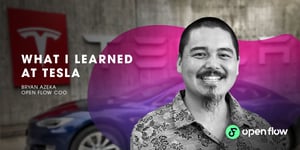By Bryan Azeka
Before joining Open Flow, our intrepid Chief Operating Officer Bryan Azeka, worked as a Delivery Experience Specialist at Tesla. (He also worked at GoDaddy, taught entrepreneurship classes at Arizona State University AND runs his family’s beloved Hawaiian sauce brand—Bryan is a baller!)
Here’s what Bryan observed about CRM during his time at Tesla.
The two years I spent working within Tesla’s delivery division taught me a lot about customer relationship management.
In my role, I acted as the primary point of contact with Tesla customers from the moment they purchased a vehicle. Management was clear that the Tesla delivery experience needed to match the innovation and singularity of the products. I answered a dizzying array of delivery-related questions (understandable as Tesla customers are essentially buying a computer-on-wheels with a Silicon Valley systems architecture). I also supervised deliveries to customers and conducted full vehicle orientations with them. We used Salesforce as our CRM (I like HubSpot much better, but that’s a topic for another post).
Of course, no system is perfect—snafus still happened. Tesla is still a startup, it’s just a really big one. We delivered cars in the wrong color (very, very rarely, but it did happen). But by focusing on flow, we were better able to address internal process issues, improve our communication, enhance collaboration and ensure smooth transitions for customers.
My top three takeaways from my time at Tesla:
1. The biggest thing for any business is staying in flow.
From Marketing, Sales and Finance departments to the Engineering, Delivery, and Service, we all needed to shift information, development and workflow changes, and actual vehicles from one place to the next, continually moving information and products down a path. Same for our customer journey and sales cycle. Internally and externally, best-in-class CRM is about creating an open flow, and you need a seamless internal process if you’re going to deliver on the promises you make to your customers.
Of course, no system is perfect—snafus still happened. Tesla is still a startup, it’s just a really big one. We delivered cars in the wrong color (very, very rarely, but it did happen). But by focusing on flow, we were better able to address internal process issues, improve our communication, enhance collaboration and ensure smooth transitions for customers.
2. Data is everything—and, great data requires great employees, working in concert.
Having the correct customer data is everything—but the best system in the world will be insufficient if you don’t have smart staff implementing that system, through detailed notes, consistent tracking, and a commitment to keeping par with customer expectations.
In my two years at Tesla, I handled 400 customers per quarter and a minimum of 40 customer calls a day from customers who could spend as much as $180,000 with us.
I have a Lean 6 Sigma Black Belt certification in leading complex improvement projects—and even so, there was no way I could track all of these individual journeys for each custom-built car without a CRM to organize the data, kept up to date with meticulous updates from Sales and Service. We all had to be working in concert with transparency to deliver. You can have the world’s best CRM, but you need talented, motivated, invested people if you want that CRM to deliver.
3. The best CRM is the one that provides a valuable experience and allows you to deliver good service.
Good service is do-or-die. Regardless of which CRM you use, you can’t get to enterprise without good service. Salesforce is still the leading CRM because Fortune 500 companies want something hyper-developed, which makes sense, because that’s what they need.
But the most expensive, highest-ranked CRM isn’t necessarily going to be the best fit for your business. If you’re not a billion-dollar company, Salesforce may be too much for your team and too hard to scale.
Salesforce is not user-friendly for some. It has countless functionalities to address a wide range of customer needs—but proliferating functionalities can mean users have to dig through endless options in order to find what they need. Making changes in Salesforce is difficult, and usually requires a developer to implement them. For me to make changes at Tesla, I needed approvals, many of which had to be run to the top of the flagpole. Lengthy approvals processes don’t promote flow.
In contrast, HubSpot is set up so that you don’t need a programming degree to customize it. While Salesforce was built by engineers, HubSpot is built by programmers. It’s made to be easy to use and easy to alter, and its smaller size allows for nimble changes.
Again: there isn’t necessarily a right CRM or even a right way to implement CRM—but customer experience is everything. Whatever CRM you use, the one that allows you to have continued positive engagement w/client, and escort them down the path of the customer journey is the best one for you and your team.
Want to discuss ways to improve your customer journey? Let’s talk!
